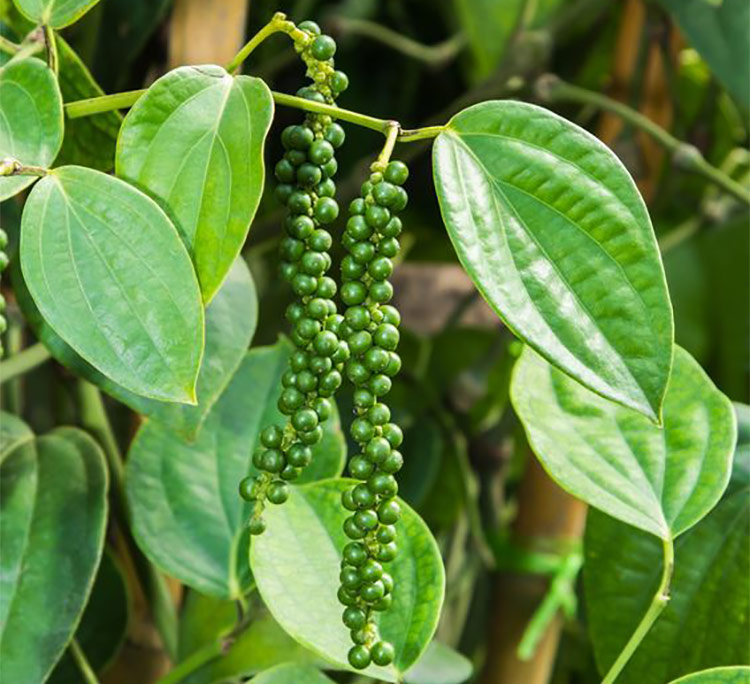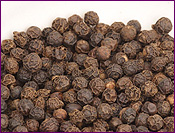Black Pepper Essential Oil
Piper nigrum

Description
The aroma of Black Pepper Essential Oil is reminiscent to freshly ground peppercorns, but it is a bit more complex with hints of green and perhaps a bit of floral. Black Pepper Essential Oil has one major advantage: it doesn't irritate your eyes or make you sneeze like ground peppercorns can.

Aromatically, Black Pepper Essential Oil shines best when incorporated into blends with other essential oils. Black Pepper really helps to perk up and add heat and spice to your blends. It is a middle note and can help to bring together fleeting top notes and heavy base notes. Black Pepper Oil blends well with most other essential oils including other spice oils, citrus and floral oils. It can be used as a substitute for Pink Pepper Oil.
Therapeutically, Black Pepper Oil helps to improve circulation and can help to ease the pain of aching muscles. I have used it, appropriately diluted, to help when arthritis had been causing severe pain in my knee.

Although Black Pepper Essential Oil offers numerous benefits, it does not contain piperine, the constituent that is responsible for helping to improve the absorption of tumeric. Some sources mistakenly claim that it does contain piperine.
Emotionally, Black Pepper Essential Oil is stimulating and is a good choice for inclusion in blends intended to help enhance alertness and stamina. Black Pepper should be avoided before bedtime.
In her book Aromatherapy Science, Maria Lis-Balchin mentions a small study that may indicate that cigarette cravings may be decreased by inhaling Black Pepper Essential Oil. [Maria Lis-Balchin, Aromatherapy Science: A Guide for Healthcare Professionals (United Kingdom: Pharmaceutical Press, 2006), 101.] For more information on smoking cessation, see AromaWeb's Guide to Essential Oils and Aromatherapy Techniques That May Help With Your Efforts to Quit Smoking article.
Black Pepper Essential Oil Benefits and Uses
Cognitive support and brain health. Source: Dorene Petersen, Presentation: Clinical Use of Aromatherapy for Brain Health: 7 Essential Oils. August 9, 2017, New Brunswick, NJ. Alliance of International Aromatherapists 2017 Conference. AIA 2017 Conference Proceedings page 221-222.
- Aching Muscles
- Arthritis
- Chilblains
- Constipation
- Muscle Cramps
- Poor Circulation
- Sluggish Digestion
- Quitting Smoking and Nicotine Addiction
References: Julia Lawless, The Encyclopedia of Essential Oils (Updated Edition) (London: Harper Thorsons, 2014), 162-163. Maria Lis-Balchin, Aromatherapy Science: A Guide for Healthcare Professionals (United Kingdom: Pharmaceutical Press, 2006), 101.
Botanical Name
Plant Family
Common Method of Extraction
Steam Distilled
Plant Part Typically Used
Color
Clear
Consistency
Thin
Perfumery Note
Middle
Strength of Initial Aroma
Medium
Aromatic Description
Black Pepper Essential Oil smells crisp, fresh and somewhat peppery.
Major Constituents
- Limonene
- Pinene
- Myrcene
- Phellandrene
- Beta-caryophyllene
- B-bisabolene
- Sabinene
- Linalol
- Pinocarveol
- a-Terpineol
- Camphene
- a-Terpenene
Source: Shirley Price, The Aromatherapy Workbook (Hammersmith, London: Thorsons, 1993), 54-5.
Black Pepper Essential Oil Safety Information
Tisserand and Young do not indicate any special precautions when using Black Pepper Oil. However, they precaution to avoid use of the oil if it has oxidized. Reading Tisserand and Young's full profile is recommended. [Robert Tisserand and Rodney Young, Essential Oil Safety (Second Edition. United Kingdom: Churchill Livingstone Elsevier, 2014), 384-385.]
General Safety Information
Do not take any oils internally and do not apply undiluted essential oils, absolutes, CO2s or other concentrated essences onto the skin without advanced essential oil knowledge or consultation from a qualified aromatherapy practitioner. For general dilution information, read AromaWeb's Guide to Diluting Essential Oils. If you are pregnant, epileptic, have liver damage, have cancer, or have any other medical problem, use oils only under the proper guidance of a qualified aromatherapy practitioner. Use extreme caution when using oils with children and be sure to first read the recommended dilution ratios for children. Consult a qualified aromatherapy practitioner before using oils with children, the elderly, if you have medical issues or are taking medications. Before using this or any essential oil, carefully read AromaWeb's Essential Oil Safety Information page. For in-depth information on oil safety issues, read Essential Oil Safety by Robert Tisserand and Rodney Young.
Shelf Life
Important Information About the Profiles
The essential oil information provided on AromaWeb is intended for basic educational purposes only. The references to safety information, test results, constituents and percentages is generalized information. Essential oils can vary greatly in composition. The data is not necessary complete and is not guaranteed to be accurate. The essential oil photos are intended to represent the typical and approximate color of each essential oil. However, essential oil composition and color can vary based on harvesting, distillation, age of the essential oil and other factors. Profiles for several CO2 Extracts and absolutes are included within the directory, and are denoted as such.
